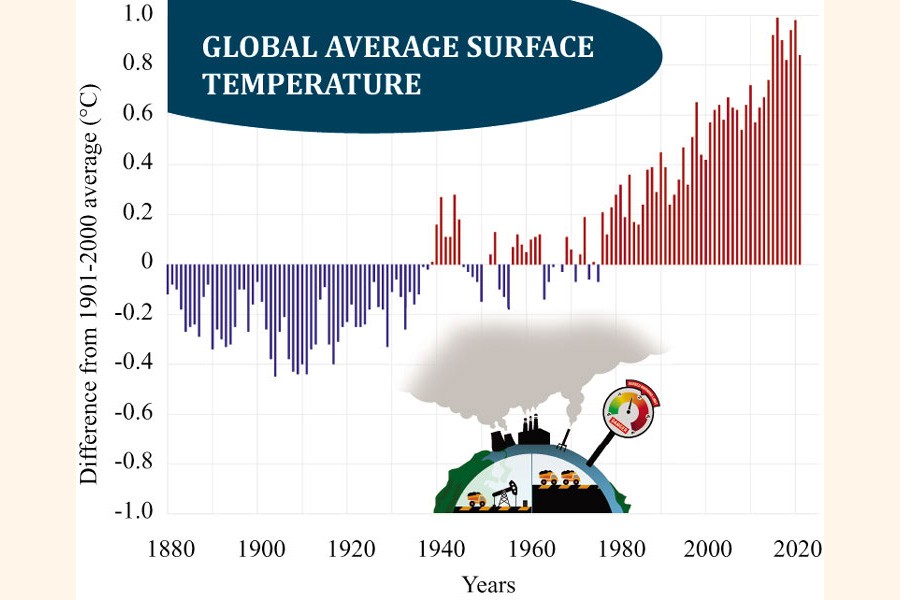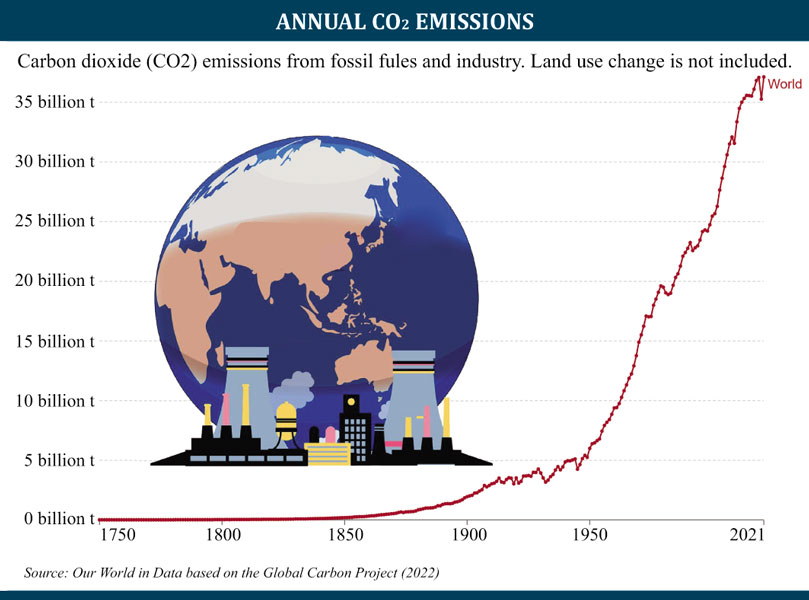
 Just a few decades back hardly anyone talked about global warming and much less about climate change, even though the effects of fossil fuel burning and the impending warming of the earth had been talked about for over a century, albeit limited mostly to the scientific community. It only gathered steam with the formation of the Intergovernmental Panel on Climate Change (IPCC) in 1988 and the call for a global treaty on climate change by UK Prime Minister Margaret Thatcher in a speech to the United Nations the following year.
Just a few decades back hardly anyone talked about global warming and much less about climate change, even though the effects of fossil fuel burning and the impending warming of the earth had been talked about for over a century, albeit limited mostly to the scientific community. It only gathered steam with the formation of the Intergovernmental Panel on Climate Change (IPCC) in 1988 and the call for a global treaty on climate change by UK Prime Minister Margaret Thatcher in a speech to the United Nations the following year.
A planet in distress
Let's first try to understand how our planet provides for us. The earth maintains a delicate, yet robust balance among all its natural processes to provide all species with goods and services such as clean air, water, climate regulation, natural pollination, food, etc., just to mention a few, through a wide network of ecosystems that are circular by nature. For instance, if the gazelle population were to suddenly increase in the Serengeti Plains in Africa, the lion population would also increase in tandem to keep the grazing in check, thus keeping that ecosystem in balance. Of the millions of species on earth, human beings are the only species that meddle with natural processes to advance their own agenda - perhaps that is the reason why we are the only species that also pays rent to inhabit the planet.
 The advent of the Industrial Revolution in the second half of the 18th century in Great Britain, continental Europe, and the United States, rapidly moved those economies from hand production methods to machines. That resulted in a dramatic increase in output that alsoled to tremendous wealth creation and an ever-increasing standard of living, not just for the rich but the common man as well, especially after mass production was introduced with the onset of the second industrial revolution.One would argue that tremendous inequities still exist - and they do. But on the whole, the average man's life has changed for the better.
The advent of the Industrial Revolution in the second half of the 18th century in Great Britain, continental Europe, and the United States, rapidly moved those economies from hand production methods to machines. That resulted in a dramatic increase in output that alsoled to tremendous wealth creation and an ever-increasing standard of living, not just for the rich but the common man as well, especially after mass production was introduced with the onset of the second industrial revolution.One would argue that tremendous inequities still exist - and they do. But on the whole, the average man's life has changed for the better.
Subsequent advancements in science and technology have seen mankind achieve the once unachievable in almost all facets of our lives. However, all this advancement has come at a great price to nature. We have used natural resources at a far greater pace than nature is capable of replenishing. Earth Overshoot Day marks the date when humanity's demand for ecological resources and services in a given year exceeds what Earth can regenerate in that year. We maintain this deficit by liquidating stocks of ecological resources and accumulating waste, primarily carbon dioxide in the atmosphere. (Earth Overshoot Day 2022 lands on July 28).We now need 1.75 earth to support our consumption.
Global warming occurs when carbon dioxide, methane, nitrous oxide, sulphur dioxide, water vapour, and other fluorinated gases,known as greenhouse gases (GHG), collect in the atmosphere and absorb sunlight and solar radiation that have bounced off the earth's surface. Normally this radiation would escape into space, but these gases trap the heat like a blanket and cause the planet to get hotter. The unprecedented amount of greenhouse gases, mostly by burning fossil fuels such as coal, oil, natural gas, etc., that has been produced and released into the atmospherein our production processes has now reached a tipping point. The other major contributors are deforestation and livestock farming. In 2021, the combined heating influence of all human-produced greenhouse gases was 49 percent higher than it was in 1990.All inpursuit of a higher and higher standard of living and mankind's insatiable appetite for consumption.
Worldwide consumption and production, a driving force of the global economy, rest on the use of the natural environment and resources in a way that continues to have destructive impacts on the planet. Economic and social progress over the last century has been accompanied by environmental degradation that is endangering the very systems on which our future and our very survivaldepend.
Since the Industrial Revolution, the global annual temperature has increased in total by roughly1degree Celsius resulting in a mostly permanent and irreversible change in the planet's climate. Between 1880 and 1975, it rose by approximately 0.35 degrees Celsius. Since the mid-seventies, however, the rate of increase has gone up dramatically adding almost 0.6 degrees Celsius to the planet's surface temperature. This may not seem much, but the trajectory is not only alarming but scary and will have a catastrophic affect on all life on the planet. The following graph from National Oceanic and Atmospheric Administration (NOAA) says it all.
According to NCEI (National Centers for Environmental Information), the year (2021) culminated as the sixth warmest year on record for the globe with a temperature that was 0.84°C (1.51°F) above the 20thcentury average. The years 2013-2021 all rank among the ten warmest years on record. The year 2021 was also the 45thconsecutive year (since 1977) with global temperatures, at least nominally, above the 20thcentury average. Of note, the year 2005, which was the first year to set a new global temperature record in the 21stcentury, currently ties with 2013 as the 10th warmest year on record, and 2010 ranks as the ninth warmest on record.
According to the United Nations, GHG concentrations are at their highest levels in 2 million years.
Other consequences
Besides GHG and global surface temperature discussed so far, there are a host of other related phenomena that is occurring across the globe that are equally alarming. A few of them are:
a) Arctic Sea Ice - Based on September 2022 data when compared with the average data from 1981 - 2010, the Artic Sea ice has shrunk by 1.54 million square kilometers - an area larger than the State of Alaska in the United States of America. At the current rate, sea ice is shrinking by 12.6% per decade. In the 2017 issue of NOAA's Arctic Report Card, scientists reported that today's low extent is far lower than anything that's occurred over at least the past 1,500 years. Not only that, but it is well outside the range of natural variability during that period. Less Arctic ice means more of the sun's heat can reach the earth without being reflected, thus causing more warming.
b) Mountain Glaciers - are retreating at an alarming rate and some are disappearing altogether. This causes sea levels to rise and threatensa key source of potable water for people and nature. Hundreds of millions of people depend on these glaciers as their very source of water.Glaciers cover about 10 per cent of Earth's land surface and glacial ice is the largest reservoir of fresh water on Earth, holding with ice sheets about 69 percent of the world's freshwater. The rate of ice sheet loss has increased by 400 per cent in just 20 years.
c) Extreme Weather - Scientists now believe with a great degree of certainty that droughts, floods, cyclones, etc. are more frequent and have higher intensity because of the effects of climate change. Floods are the most widespread of all weather-related natural disasters.Many people think climate change mainly means warmer temperatures. But the temperature rise is only the beginning of the story. Because the Earth is a system, where everything is connected, changes in one area can influence changes in all others.
d) Warming Oceans - Sea-level has increased by 0.2 metres in the last 120 years and is accelerating. 50 per cent of that increase is due to thermal expansion, 22 per cent due to Glacier ice loss, and 20 per cent due to Ice Sheet loss. The oceans have warmed faster in the past century than at any time in the last 11,000 years. Even if global warming is limited to 1.5 degrees Celsius, the oceans will rise by 2-3 metres over the long run. Changes are irreversible on centennial to millennial time scales in global ocean temperature, ocean acidification, and de-oxygenation.
e) Carbon Dioxide - As of October 2022, the concentration of CO2 has hit 419 parts per million (ppm) in the atmosphere causing ocean acidification that has serious ramifications. Between 1751 and 2021 ocean surface acidity increased from pH 8.25 to 8.14 as a result of an increase in atmospheric CO2 concentrations. This corresponds to an increase in oceanic acidity of about 30 per cent. This decrease in pH occurred at a rate about 100 times faster than any change in acidity experienced during the past 55 million years. It is estimated that our oceans absorb anywhere between 25 - 40 per cent of the CO2that is released. This has a direct impact on marine life and the ocean ecosystem on which a billion lives depend.
Carbon inequities
From time immemorial, individuals to nations, and everything in between, have wanted more. It has never been about the need. The earth has enough resources to fulfill the needs of everyone, but not their greed. According to a recent study conducted by Oxfam and the Institute for European Environmental Policy, the richest 1 per cent of the world's population emit between 25-30 times more than the global average that is needed to maintain the Paris 1.5 degrees Celsius cap, whereas the bottom 50% could emit a whole lot more and still stay well below the threshold of the Paris agreement.
'Over the past 25 years, the richest 10 per cent of the global population has been responsible for more than half of all carbon emissions... Rank injustice and inequality on this scale is a cancer. If we don't act now, this century may be our last' saidAntonio Guterres, UN Secretary-General.
Similarly, rich nations continue to consume a disproportionate amount of global resources at the expense of the rest of the world. The rapid industrialisation of the west is responsible for the sick planet that we have today, yet the poor of the world have to deal with the aftermath. The developed countries have yet to step up to the plate and take ownership of the problem. Trillions of dollars in new funding are needed immediately before it is too late.
Recent Climate Change achievements &milestones
1972 - First UN environment conference in Stockholm. Climate change hardly registers on the agenda, which centres on issues such as chemical pollution, atomic bomb testing, and whaling. The United Nations Environment Programme(UNEP) is formed as a result.
1987 - Montreal Protocolrestricting chemicals that damage the ozone layer.
1988 - Intergovernmental Panel on Climate Change (IPCC) was formed to collate and assess evidence on climate change.
1989 - UK Prime Minister Margaret Thatcherin a speech to the UNcalls for a global treaty on climate change. Carbon emissions from fossil fuel burningreach six billion tonnes per year.
1992 - At the Earth Summit in Rio de Janeiro, governments agree to the United Framework Convention on Climate Change (UNFCCC) to stabilisethe greenhouse gas concentrations in the atmosphere at a level that would prevent dangerousanthropogenic interference with the climate system. Developed countries agree to return their emissions to 1990 levels.
1995 - The Conference of the Parties (COP) to the United Nations Framework Convention on Climate Change held its first session in Berlin, Germany.
1997 - Developed nations pledge to reduce emissions by an average of 5 per cent by the period 2008-12 through the Kyoto Protocol. US Senate immediately declares it will not ratify the treaty. Adaptation Fund (AF) was established under the Kyoto Protocol in 2001.
2005 - The Kyoto Protocol becomes international law for those countries still inside it.
2006 - The Stern Review concludes that climate change could damage global GDP by up to 20 per cent if left unchecked - but curbing it would cost about 1 per cent of global GDP.
2009 -192 governments convene for the UN climate summit in Copenhagen with high expectations; but they leave only with a controversial declaration, the Copenhagen Accord.China overtakes the US as the world's biggest greenhouse gas emitter - although the US remains well ahead on a per-capita basis.
2010 - Green Climate Fund (GCF) established at COP 16. Through the Cancun Agreements,Developed Country Parties committed to a goal of mobilizing USD 100 billion per year by 2020 to address the needs of developing countries. Besides the Global Environment Facility (GEF) established in 1994, and the Adaptation Fund in 2001, the Parties also created two special funds -- the Special Climate Change Fund (SCCF) and the Least Developed Countries Fund (LDCF).
2015 - 196 parties adopted The Paris Agreement at COP 21 in Paris. The landmark agreement is the first time that all nations came together under one binding agreement to limit global warming to 2, preferably to 1.5 degrees Celsius, compared to pre-industrial levels.The Paris Agreement provides a framework for financial, technical, and capacity-building support to those countries that need it. Under the agreement, countries submit their Nationally Determined Contributions or NDCs by 2020 as well as a non-mandatory long-term strategy for a low GHG future called the LT-LED.
2021 - COP 26 held in Glasgow with the signing of the Glasgow Climate Pact and agreeing on the Paris Rulebook. The main goal was to secure global net zero by mid-century and keep a maximum of 1.5 C degrees of warming within reach. Net zero means total emissions are equal to or less than the emissions removed from the environment.
2022 - COP27 held in Egyptreaches Breakthrough Agreement on New "Loss and Damage" Fund for Vulnerable Countries. The cover decision, known as the Sharm el-Sheikh Implementation Plan, highlights that a global transformation to a low-carbon economy is expected to require investments of at least USD 4-6 trillion a year.
Bangladesh perspective
The effects of global warming are devastating Bangladesh and destroying the livelihoods of millions, particularly increased cyclones and flooding that bring saltwater further inland. Bangladesh, a country of about 170 million, has historically contributed a fraction of the world's emissions, and yet the low-lying delta nation is hard hit by climate change.
Year after year floods break through the mud embankments, washing away crops and village homes. Over a million hectares of land are affected due to increased salinity. Rising seas will make millions homeless. And, Bangladesh is not alone - many low-lying and poor island nations are at grave risk which is both real and omnipotent.
According to the IPCC Fifth Assessment Report published recently, the sea level of the Bay of Bengal is rising at a rate of 1.5 mm per year. Bangladesh with the Bay of Bengal in the South will be directly affected by the sea-level rise because of its low elevation. If the sea level rises by 45 cm, a permanent loss of up to 15,600 square kilometres of land is expected. Scientists predict that rising sea levels to submerge 17 - 20 percent of Bangladesh's land area,and will displace 18 million people by 2050.
With the help of development partners and the World Bank, the Government of Bangladesh (GoB) established Bangladesh Climate Change Resilience Fund (BCCRF) in May 2010. This fund is enabling the GoB to channel over US$ 188 million to millions of Bangladeshis to fight the effects of climate change. GoB has another fund called the Bangladesh Climate Change Trust Fund to address the climate change effects. It has allocated US$ 350 million from its resources for the last five years consecutively from 2009 to 2013. But billions are needed to avoid catastrophe.
A decade-old deal for rich countries to give poor nations USD100bn each year to switch to clean energy and adapt to climate change has yet to be fulfilled. Even the money that is being provided is spread too thin to make much of a difference on the ground.
Despite seeing its gross domestic product (GDP) rise from $6.2bn in 1972 to $460bn in 2022, Bangladesh cannot pay for the cost of global warming on its own.
The west should clean up its own mess!
The author is the Managing Director of Engineering Resources International (ERI) -
a sustainable development engineering company.
© 2025 - All Rights with The Financial Express
